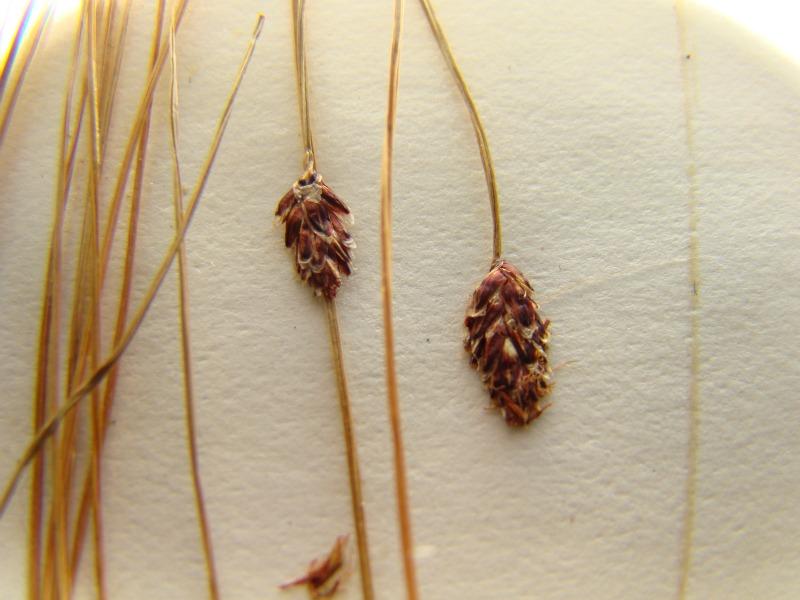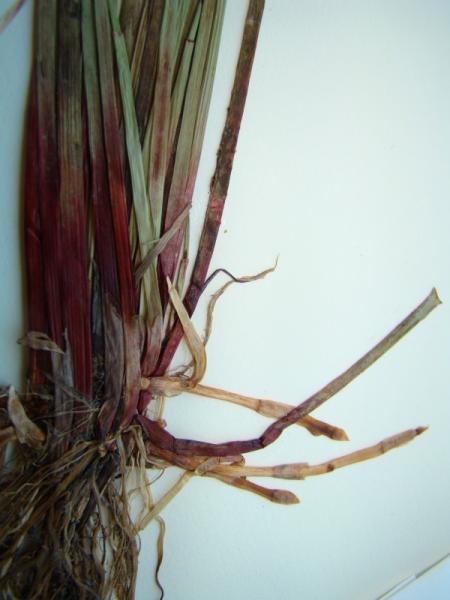Sharp-angled Spike Rush
Eleocharis tenuis var. pseudoptera (Weatherby ex Svens.) Svens.
- Class
- Monocotyledoneae (Monocots)
- Family
- Cyperaceae (Sedge Family)
- State Protection
- Endangered
Listed as Endangered by New York State: in imminent danger of extirpation in New York. For animals, taking, importation, transportation, or possession is prohibited, except under license or permit. For plants, removal or damage without the consent of the landowner is prohibited.
- Federal Protection
- Not Listed
- State Conservation Status Rank
- S1
Critically Imperiled in New York - Especially vulnerable to disappearing from New York due to extreme rarity or other factors; typically 5 or fewer populations or locations in New York, very few individuals, very restricted range, very few remaining acres (or miles of stream), and/or very steep declines.
- Global Conservation Status Rank
- G5T5?
Secure globally (most likely) - Conservation status of the subspecies/variety is uncertain, but is most likely common in the world; widespread and abundant (but may be rare in some parts of its range). More information is needed to assign a firm conservation status. (The species as a whole is common globally.)
Summary
Did you know?
In Quebec this species is known as winged-stem spike-rush because the stems are deeply grooved and thus " falsely winged" (the meaning of pseudoptera) (Flora of North America Editorial Committee 2002).
State Ranking Justification
There are five existing populations, most of them of good quality and in protected areas. There are 12 records from the late 1800s through 1974 that have not been rechecked.
Short-term Trends
Three of the five populations have been rechecked at least once and numbers remain about the same.
Long-term Trends
This plant has always been very rare in New York and populations remain at a low level. Old records have not been rechecked so long-term trends are unclear.
Conservation and Management
Threats
Exact threats are unknown at this time.
Conservation Strategies and Management Practices
No management is needed until more study is done of the sites where it occurs.
Research Needs
More survey work is needed to determine the exact range of this species and the habitat it prefers.
Habitat
Habitat
There are two New York sites for Slender Spikerush with known habitat information; one is a have been described; one was wet, clayey oldfield, and the other a mowed roadside in a wet pine barrens. More information on the habitat requirements of Slender Spikerush in New York is needed (New York Natural Heritage Program 2010). Wet, fresh, often calcareous meadows, swales, springy places, woods, prairie, serpentine barrens, ditches (FNA 2002). Wet places (Gleason & Cronquist 1991).
Associated Ecological Communities
- Coastal plain pond shore*
(guide)
The gently sloping shore of a coastal plain pond with seasonally and annually fluctuating water levels. Plants growing on the pond shore vary with water levels. In dry years when water levels are low there is often a dense growth of annual sedges, grasses, and herbs. Submerged and floating-leaved aquatic plants, such as fragrant waterlily and pondweeds, may become "stranded" on the exposed shore. In wet years when the water level is high only a few emergents and floating-leaved aquatics may be noticeable. T
- Mowed roadside/pathway
A narrow strip of mowed vegetation along the side of a road, or a mowed pathway through taller vegetation (e.g., meadows, old fields, woodlands, forests), or along utility right-of-way corridors (e.g., power lines, telephone lines, gas pipelines). The vegetation in these mowed strips and paths may be dominated by grasses, sedges, and rushes; or it may be dominated by forbs, vines, and low shrubs that can tolerate infrequent mowing.
- Sedge meadow*
(guide)
A wet meadow community that has organic soils (muck or fibrous peat). Soils are permanently saturated and seasonally flooded. The dominant herbs must be members of the sedge family, typically of the genus Carex.
- Successional old field
A meadow dominated by forbs and grasses that occurs on sites that have been cleared and plowed (for farming or development), and then abandoned or only occasionally mowed.
* probable association but not confirmed.
Associated Species
- Artemisia vulgaris (mugwort)
- Asclepias incarnata
- Carex bullata (button sedge)
- Carex silicea (beach sedge)
- Carx vestita
- Drosera intermedia (spatulate-leaved sundew)
- Equisetum arvense (field horsetail, common horsetail)
- Lotus corniculatus (common bird's-foot-trefoil)
- Lycopodiella inundata (northern bog-clubmoss)
- Panicum virgatum (switch grass)
- Polygala lutea (orange milkwort)
- Quercus palustris (pin oak)
- Rhynchospora capitellata (brownish beak sedge)
- Rubus hispidus (swamp dewberry)
- Solidago latissimifolia (Elliott's goldenrod)
- Triadenum virginicum
- Tripsacum dactyloides
- Viola lanceolata (lance-leaved violet)
- Viola primulifolia
- Xyris
Range
New York State Distribution
This spikerush is currently known from Suffolk County on Long Island and in the Bronx. It has been extirpated from Queens and was also historically known from Lake Carmel in Putnam County.
Global Distribution
This spikerush occurs mostly east of the Mississippi, from Québec and Nova Scotia and south to Georgia in the east, and from Indiana south to Louisiana in the west.
Identification Comments
General Description
Spikerushes consist of a simple stem (the leaves bladeless and inconspicuous), with the infloresence a solitary, many-scaled spikelet at the top of the stem. The perianth (sepals and petals), if present, is reduced to bristles. The base of the style is expanded into a tubercle, and is usually persistent on the fruit (achenes). Slender Spikerush is a perennial, mat-forming species, growing from rhizomes. Its stems have 4 to 5 sharp angles, and the leaf sheaths are reddish at the base and toothed at the apex. Some or all of the upper leaf sheaths have a stout apical tooth 0.4-0.6 (0.9)mm tall. The spikelets are egg-shaped and 3-6 millimeters long and 1.5 to 2 mm wide. There may be 1 to 3 slender bristles, as long or shorter than the achenes. The achenes are trigonous, yellow, angled, and wrinkled (under 10 -20x magnification) with 10 to 14 depressions in each vertical row. The flower scales persist on the spikelet at least until the achenes fall (FNA 2002).
Best Life Stage for Proper Identification
Mature fruit is necessary for identification.
Similar Species
Eleocharis tenuis var. tenuis is also found in New York. It has smooth to bluntly angled stems 0.5 millimeters or less wide. The upper leaf sheaths have a slender apical tooth to 0.2mm tall. The green to brown achenes have tubercles as high as they are wide.
Eleocharis elliptica has stems with (4) 6-8 angles, not sharply winged, or sometimes rounded or compressed. the yellow to yellow-orange achenes are persistent after the scales fall, and have 12 to 20 horizontal ridges per vertical row (FNA 2002).
Best Time to See
Fruits are present from July through mid-October.
- Fruiting
The time of year you would expect to find Sharp-angled Spike Rush fruiting in New York.
Sharp-angled Spike Rush Images
Taxonomy
Sharp-angled Spike Rush
Eleocharis tenuis var. pseudoptera (Weatherby ex Svens.) Svens.
- Kingdom Plantae
- Phylum Anthophyta
- Class Monocotyledoneae
(Monocots)
- Order Cyperales
- Family Cyperaceae (Sedge Family)
- Order Cyperales
- Class Monocotyledoneae
(Monocots)
- Phylum Anthophyta
Additional Common Names
- Slender Spike Rush
Synonyms
- Eleocharis elliptica var. pseudoptera (Weatherby ex Svens.) L. Harms
Additional Resources
Best Identification Reference
Flora of North America Editorial Committee. 2002. Flora of North America, North of Mexico. Volume 23. Magnoliophyta: Commelinidae (in part): Cyperaceae. Oxford University Press, New York. 608 pp.
Other References
Fernald, M.L. 1950. Gray's manual of botany. 8th edition. D. Van Nostrand, New York. 1632 pp.
Gleason, Henry A. and A. Cronquist. 1991. Manual of Vascular Plants of Northeastern United States and Adjacent Canada. The New York Botanical Garden, Bronx, New York. 910 pp.
Holmgren, Noel. 1998. The Illustrated Companion to Gleason and Cronquist's Manual. Illustrations of the Vascular Plants of Northeastern United States and Adjacent Canada. The New York Botanical Garden, Bronx, New York.
Mitchell, Richard S. and Gordon C. Tucker. 1997. Revised Checklist of New York State Plants. Contributions to a Flora of New York State. Checklist IV. Bulletin No. 490. New York State Museum. Albany, NY. 400 pp.
New York Natural Heritage Program. 2010. Biotics database. New York Natural Heritage Program. New York State Department of Environmental Conservation. Albany, NY.
New York Natural Heritage Program. 2024. New York Natural Heritage Program Databases. Albany, NY.
Weldy, T. and D. Werier. 2010. New York flora atlas. [S.M. Landry, K.N. Campbell, and L.D. Mabe (original application development), Florida Center for Community Design and Research http://www.fccdr.usf.edu/. University of South Florida http://www.usf.edu/]. New York Flora Association http://newyork.plantatlas.usf.edu/, Albany, New York
Links
About This Guide
This guide was authored by: Stephen M. Young and Richard M. Ring
Information for this guide was last updated on: July 8, 2021
Please cite this page as:
New York Natural Heritage Program. 2024.
Online Conservation Guide for
Eleocharis tenuis var. pseudoptera.
Available from: https://guides.nynhp.org/slender-spike-rush/.
Accessed July 27, 2024.

